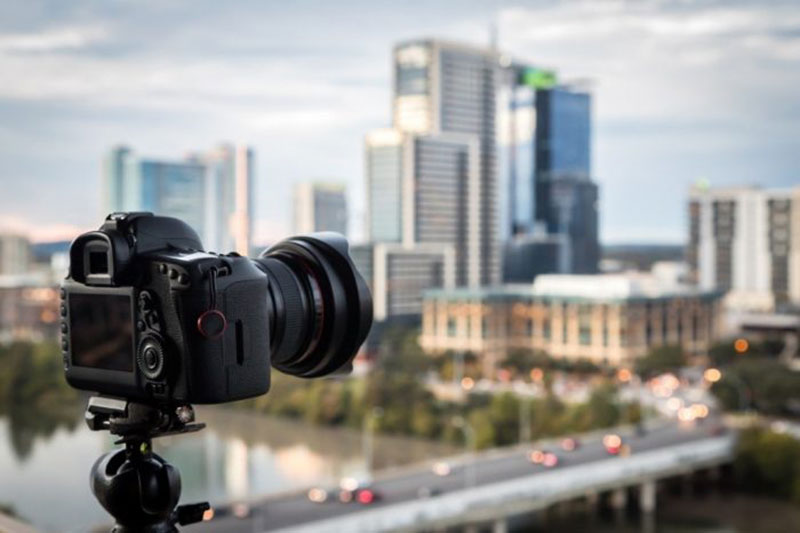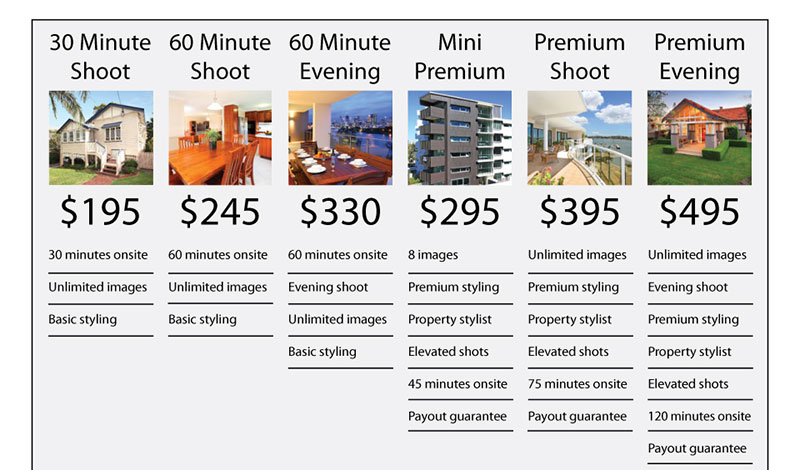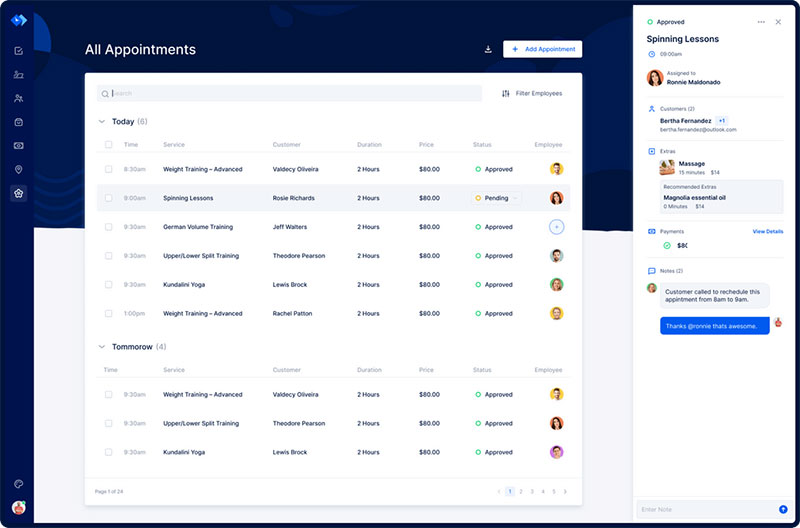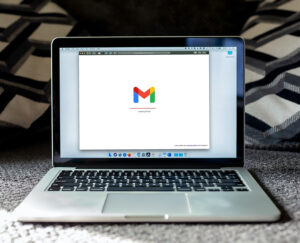For many photographers, starting a real estate photography business seems profitable. But have you ever taken the time to calculate what the pricing of your services should be? If so, you’re not alone. For many photographers, it’s a challenge to price their services. And even more so for real estate photography. If the prospect of calculating pricing stresses you out, breathe a sigh of relief. This article will explain the pricing for a real estate photography services business.
What the Data Says About Real Estate Photography Pricing

The pricing for professional photography services is not the same for all photographers. It depends on the type of product or service that you’re offering. For real estate photography, the photos alone may cost a few hundred dollars. Higher-end photos can cost up to thousands of dollars and might include premium add-ons.
In the United States, data shows that, in the 50 largest cities, real estate photography services cost between $93-$300 per session. Generally speaking, this price is based on a 3,000 square-foot home and includes 10-25 MLS-ready photos.
Let’s have a look at what real estate photographers charge in a few different states and cities in particular:
- Maine – One real estate photographer charges $225 for homes over 3,000 square feet and $190 for homes under 3,000 square feet. And that price does not include videography.
- Utah – One real estate photographer charges $130 for photos and $300 for videography.
- Charleston, South Carolina – One real estate photographer charges $500 per listing. The listing price for the homes that she shoots averages about $1.3 million.
- Miami – One real estate photographer charges between $250-$500 for photos.
Determining the appropriate pricing for real estate photography services can be a challenge. Price your services too low, and you lose the opportunity to make good money. But price them too high, and very few clients will be able to work with you. Read on to see how you can price your services according to their worth.
What to Consider When Setting Your Pricing and Packages
Experience

Whether you work for a photography company or have your own business, your experience in the industry can determine your income. Even if a new photographer does the same work as a highly-rated one, the one with less experience will earn less.
Simply knowing how to use a camera does not make one a seasoned photographer. Clients are looking for photographers who can capture and bring attention to the most beautiful aspects of a home or other property. This ability only comes with training and experience.
Cost of Transport
Some of your clients may have properties right in your community. Others, though, may have properties that require you to drive or take public transportation. Whether it takes you only 10 minutes or over 2 hours to get to the property, you will still have to spend money on gas. So, count the cost of transportation when pricing your services. Another option is to lower the price for the services but ask the client to reimburse transportation costs.
The good news is, if you’re in the United States, the IRS allows businesses to write off 56 cents per mile driven in your vehicle as a business expense. (Keep in mind that, once you start working, you have a business as far as the IRS is concerned, whether you’ve set up an LLC or not.)
Communication With Clients
When pricing your services, consider the amount of time you spend communicating with clients. This is so regardless of whether by phone, email, or other means.
Client communication also includes educating them about what you expect for the photoshoot. Have them clean and declutter the property before you get there to avoid wasting time.
It takes time to discuss your expectations, as well as the client’s needs and how long the photoshoot should take. It counts as work and thus should be included in your pricing.
Equipment

You don’t need to have the fanciest and newest equipment to be a great photographer. But, you do need to have the right equipment to do the best work possible.
All that may be needed are a camera, lenses, a tripod, and some lighting. Don’t spend all your money trying to get the latest and greatest equipment there is. This is especially true if you’re just starting your real estate photography business. If you spend more money than necessary, your business will become unprofitable as a result. Instead, invest in just the right equipment that will help you do your job well.
Here is a list of the basic tools you need for a photoshoot:
- Main camera body, as well as a spare one
- Wide-angle, prime, zoom, and tilt-shift lenses
- Memory cards
- Speedlight
- Strobe, umbrella, and softboxes
- Reflectors and diffusers
- Tripod
- Batteries for camera and flash
- Chargers and cords
- Computer or laptop for editing photos
Post-processing
Post-processing is another task that photographers must take time to do. This usually takes hours longer than the actual photoshoot. Editing photos involves replacing skies, balancing brightness, enhancing colors, removing unwanted clutter, and hundreds of more adjustments. In addition, Adobe Lightroom and Adobe Photoshop, even though the best editing programs available, also cost money.
Rather than edit your photos yourself, however, you may opt to outsource this service. If you need to edit 20 photos, and it costs $2 per photo, you will have to add this to the total cost of your photography service. Of course, you would adjust this number for each photoshoot package depending on the number of photos you agreed to deliver to the client.
Turnaround and Timing
Real estate agents would expect a turnaround time of no more than 48 hours after the photo shoot. Others, though, may request a 24-hour turnaround time. In that case, you may set a higher price for your services to compensate for the extra effort you’ll need to get the photos to the client on time.
If you’re constantly fulfilling requests to photograph properties on short notice or deliver photos to a client within a short time, it could very well interfere with your personal life. You might charge a higher price for these shoots to make the extra time and effort worth it.
If clients need their photos sooner than 24 or 48 hours, you can charge a higher price. Additionally, being extra flexible and accommodating will set you apart from your competitors.
Get more bookings with the right tool for the job
Staying organized has never been easier.
You can now manage your business and grow your brand with a single, powerful software that keeps all of your appointments in line, your clients organized and your business booming.
Trafft is perfect for business owners who need to streamline their booking experience both for their staff and their clients.
Trafft handles everything for you, even sending automated email or SMS reminders to your clients. No-shows? Not anymore!
The Trafft booking software adapts to different industries for a blissful online booking experience and employee management.
Want to know more? Check out Trafft’s awesome features to see what you are missing.
Fixed Costs
Among others, these are the basic costs that real estate photographers need to cover:
- Camera gear
- Computer
- Editing software
- Realtor board membership
- Car payments
- Insurance
Even if you’ve already purchased camera gear and a computer, they will inevitably need repairs at some point. Make sure that your pricing is high enough so that you can save money for repairs.
Your Region
Of course, your pricing will depend greatly on where you live and the cost of living there. For example, a real estate photographer living in San Francisco would be able to charge $200 for a session. But one living in Waco, Texas, would probably not be able to charge the same price.
However, this does not mean that you should sell yourself short just because you live in a smaller city or town. If you charge what you’re worth, the right clients will see the value in your work.
$200-$500 for a photoshoot is a small price for a client to pay when they have the potential to earn thousands of dollars on a sale. Many realtors earn a 6% commission on the sale of a property. If a realtor sells a home for $300,000, he earns $18,000! Or, if it’s the property’s owner or seller who hires you, that person may make hundreds of thousands of dollars on the sale.
However, whether they sell the property may depend on how well they present it to the public. That’s when your skills as a real estate photographer are needed. So, is your work really that valuable? Absolutely!
Property Type

As a real estate photographer, you may have to shoot a wide variety of properties. Different properties will take more or less time to shoot, depending on their size, which will impact your pricing. For instance, a tiny house versus a multi-story building.
When shooting large-scale properties, you might give an all-in package for a photoshoot. That package could include interiors, exteriors, and headshots of the real estate agents.
Premium Services
Real estate agents often have other needs besides photography that you’ll have to cater to. Some of these are listed below.
- Aerial or drone photography
- Videography services
- Rush turnaround pricing
- On-location proofing/delivery (shooting tethered, etc.)
- Different shoots at different times of the day
Because these services require more equipment and effort than a photoshoot alone, charging more for these premium services would be advantageous.
Business Operations
Taking photos is not the only way you need to manage your business. Being a business owner also involves managing the non-creative aspects of your business. These include planning, organizing, coordinating, controlling all photoshoot resources, and delivering products to the client.
Business operations also involve yearly financial, legal, and marketing tasks. These tasks can cost a considerable amount of time, money, and resources. So, it would help if you count the cost of running your business when pricing your services.
The Value of Your Work
How do your skills and experience help clients achieve the results that they’re looking for? If you take beautiful photos and get positive results, don’t be afraid to set a high price for these based on what they’re worth.
Also, think about what kind of business you are running. Is it a luxury brand or a budget brand?
Your Salary
What do you want to earn for the time you spend shooting? What is your time worth to you? Remember, this is only the amount of time spent shooting. This does not include the time spent doing other tasks. If you spend an hour shooting a property, is it worth $50, or perhaps $200 to you?
Whatever you determine your value to be, add that to our formula. Remember that you can adjust this price once you see all your costs.
Free Time
As is the case for any business, there will be busy and slow times throughout the year.
Before starting your business, you had a reliable income and likely paid vacation time if you had a full-time job. Small business owners only earn money for the time spent working. So, you need to make sure that your pricing structure allows you to set aside time for your personal life, sick days, and vacations.
Assume that you will be working about 44 weeks per year, which will help offset busy times, vacations, and leisure time.
8 Tips to Price Your Real Estate Photography Services
Don’t Charge Hourly

For wedding and event photographers, charging by the hour is very common. This is not so for real estate photographers. Instead, charge by the type of property, room, or square footage of the property.
Why is it not helpful to charge hourly? When photographing properties, you want to make sure you can take all the time you need to get everything just right. If you charge by the hour, but your pace is too slow for the clients’ liking, they may feel that you’re taking advantage of them.
Explore Market Needs
If you want to gain more clients, doesn’t it make sense to ask your current clients what they like and don’t like? Seeing how well you can meet your clients’ needs will influence how much you can charge for your services.
For instance, do your clients appreciate that they can speak to you directly rather than another representative? If so, be sure to remain accessible to your clients, even if others work with you.
As another example, do your clients need the fastest turnaround time possible? If so, then make sure that you simplify your process as much as possible to deliver your client’s photos when they need them.
Improve in Efficiency
The amount of money you earn from each client will typically be hundreds, not thousands, of dollars. So, how profitable your business is depends on how efficient your workflow is.
Quick turnaround times and attention to detail are very important to keep your clients. If you promise to deliver photos to the client within a specific time frame, be sure to follow through. Even if the subtle tones or colors in your post-production are slightly off, that won’t upset your clients nearly as much as getting photos late.
Also, if you take a long time on any part of the process, you might end up making much less money per hour than you would like.
Quality vs. Quantity
When it comes to real estate photography pricing, there are two basic paths that you can take:
- Focus on quantity – Photograph standard listings, but make your process simpler and faster so that you can do a large number of shoots.
- Focus on quality – Photograph high-end properties, but take all the time you need on each shoot.
The Psychology of Pricing

Another tip that business owners should know is to understand the psychology of pricing. If you offer three main packages or products, most of your clients will likely choose the middle tier.
For your bottom package, you should charge the minimum necessary that would still make the job profitable. The top package should be a “VIP experience” that would attract high-end clients.
Since the middle package is what most clients would choose, make sure that it includes everything that the average client is looking for. And keep it within your target market’s budget.
Don’t Sell Yourself Short
If photography were simple, everyone would be doing it. Clients hire photographers for the skills, knowledge, and experience that others do not have. Even if you only do a day-long photoshoot, clients pay for years’ worth of expertise. So don’t sell yourself short and feel that you need to charge low rates to gain clients. Remember your worth.
You may need to rethink how much you’re worth if you’re doing cheap jobs or free services just for the sake of being able to photograph a nice property. If a client even considers hiring you to photograph a high-end property, that in itself shows that you’re worth more than you think. By charging accordingly, you show that you’re confident in your work, as well as your own value.
Add Profit Margin
Once you calculate all your costs, you have your profit margin, and from that, you can set aside money for retirement. Remember that you are a business owner, not an employee, so be sure to save enough money for yourself!
Your net income refers to how your business earns money by dividing income by revenues. The first step is to subtract the expenses from the revenue to find your net income. Then, divide your net income by the revenue to find the net sales. Multiply the net sales by 100 to find out the profit margin percentage.
Test Your Rates
The last step after you determine your pricing is trial and error. It’s now time to present your pricing to potential clients. Notice their reactions and how it affects your sales. Get their feedback on your pricing as well. If the first pricing structure doesn’t work, be open to adjusting it. Also, it would be a good idea to audit your pricing every year to see if you need to make any changes.
FAQs about real estate photography pricing
1. What is the average cost for a real estate photography shoot?
The location, size, and experience of the photographer, among other variables, can all affect the average cost of a real estate photography shoot. A simple photo package with about 20–25 photos will cost you, on average, between $150 and $350. Prices might range from $500 to $1,500 for larger estates or more complete packages that include virtual tours or aerial photos.
2. Are there any additional fees or costs for editing or post-processing?
It’s true that some photographers charge extra for editing and post-processing services. Depending on the number of photographs and the level of editing required, this charge may change. For instance, a photographer might bill an extra $25 to $50 per image for HDR photography, significant retouching, or virtual staging.
3. How many photos are typically included in a real estate photography package?
Typically, a real estate photography package will have between 20 and 25 high-quality pictures. Depending on the size of the property, the level of detail needed, and the photographer’s experience, this figure may change.
While some photographers charge extra for more shots, others may include more photos as part of a premium package.
4. Do real estate photographers charge by the hour or by the project?
Instead of charging by the hour, most real estate photographers bill by the project. This is due to the fact that taking high-quality pictures requires a lot more work than simply spending time on site.
It is more effective to charge a fixed amount for the entire job because factors like editing, post-processing, and delivery of final photos also affect the pricing.
5. What is the turnaround time for receiving the final edited photos?
Although the turnaround time for getting the final edited pictures can differ, most photographers try to give the finished pictures 24 to 48 hours after the shoot.
Yet, some photographers could charge extra for a speedy service that can provide the finished photographs in a matter of hours.
6. Are there any discounts for repeat customers or multiple properties?
Certainly, some photographers give discounts to clients who return or who have several homes. This is due to the fact that using the same photographer for several homes can sometimes be more economical than using a new photographer for every property. Discounts of between 10 and 20 percent off the package’s total price are possible.
7. What equipment and tools do real estate photographers use to capture high-quality images?
To produce high-quality photographs, real estate photographers make use of a variety of tools and equipment. Wide-angle lenses, tripods, lighting gear, and cameras of the highest caliber can all fall under this category.
Aerial photographs of the property taken by some photographers using drones can provide prospective purchasers a distinctive viewpoint.
8. Can photographers provide virtual tours or 360-degree photos as part of their services?
Certainly, a lot of real estate photographers include 360-degree images or virtual tours in their services.
Virtual tours can assist display the property’s distinctive qualities and give potential purchasers a more immersive experience. Depending on the photographer and the complexity of the virtual tour, these extra services could incur a fee.
9. How much should I budget for real estate photography for a luxury property?
The price of real estate photography for luxury houses can vary significantly based on the size of the property, the level of detail required, and the photographer’s level of expertise.
Luxury home photography packages frequently cost between $1,500 and $5,000 or more. Other services like virtual tours or drone videos may be included at this price.
10. Are there any limitations on the usage rights for the photos taken by the real estate photographer?
Depending on the photographer’s policies and the contract that the customer signs, the usage rights for images taken by the real estate photographer may change.
Some photographers would only provide a customer a license to use the images for a certain use, like marketing a piece of real estate up for sale, while maintaining copyright ownership of the images.
Some photographers might give the client complete ownership of the pictures, letting them use them any way they want. Before hiring a photographer, it’s crucial to go over usage rights with them. You should also carefully study any contracts or agreements to make sure the terms are suitable.
Final thoughts about real estate photography pricing
Granted, calculating the price of your services is no easy task. However, it is a must to build a profitable business. The more time and effort you put into your pricing, the more comfortable you will become with it.
Hopefully, you are now ready to start your real estate photography business. If so, be sure to refer to this article to ensure that you can compete with other real estate photographers in your city or state.
Please, don’t try to match a competitor’s low pricing out of fear that you won’t get as many clients. Base your pricing not solely on your competitor’s pricing but also on how much your time, your work, and YOU are worth. You can be sure that the right clients who truly value your work will come to you if you do.
If you enjoyed reading this article on real estate photography pricing, you should also read this one about how to get your photography noticed.
We also wrote articles about similar subjects like pricing photography prints, photography mini-sessions, how to become a licensed photographer, real estate photography contracts, social media marketing for photographers, real estate photography contract, appointment scheduling for real estate agents, how to get your photography noticed and photography mood board.









